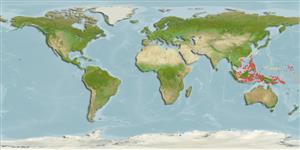>
Gobiiformes (Gobies) >
Gobiidae (Gobies) > Gobiinae
Etymology: Gobiopsis: Latin, gobius = gudgeon + Greek, opsis = appearance (Ref. 45335).
More on author: Herre.
Environment: milieu / climate zone / depth range / distribution range
Ecología
marino asociado a arrecife; rango de profundidad 3 - 15 m (Ref. 90102). Tropical; 30°N - 10°S
Distribución
Países | Áreas FAO | Ecosistemas | Ocurrencias, apariciones | Point map | Introducciones | Faunafri
Western Pacific: Philippines, Irian Jaya, and possibly Okinawa, Ryukyu Islands and Palau.
Tamaño / Peso / Age
Maturity: Lm ? range ? - ? cm
Max length : 4.1 cm TL macho / no sexado; (Ref. 90102)
Short description
Morfología | Morfometría
Espinas dorsales (total): 7; Radios blandos dorsales (total): 9-11; Espinas anales 1; Radios blandos anales: 8 - 10. Characterized by overall pale grey body color, presence of three brown saddles below base of dorsal fins (joined at midbody and usually forming continuous midlateral stripe), narrow extensions of dorsal saddles on lower side; base of caudal fin with vertically ovate spot; fully united pelvic fins, frenum present; rounded caudal fin; longitudinal scale series 28-38; presence of barbels on snout, tip of chin, and ventrally below lower jaw; cycloid scales; cheek and opercle without scales; deeply embedded nape scales; presence of sensory pores on head, including two preopercular pores; depth of body 5.6-5.8 in SL (Ref. 90102).
Found among live and dead corals on sand, in tide pools and on shallow reefs to as deep as 5 m (Ref. 1602). Cryptic (Ref. 90102).
Life cycle and mating behavior
Madurez | Reproducción | Puesta | Huevos | Fecundidad | Larva
Myers, R.F., 1991. Micronesian reef fishes. Second Ed. Coral Graphics, Barrigada, Guam. 298 p. (Ref. 1602)
IUCN Red List Status (Ref. 130435)
Threat to humans
Harmless
Human uses
Más información
Nombres comunesSinónimosMetabolismoDespredadoresEcotoxicologíaReproducciónMadurezPuestaAgregación para la puestaFecundidadHuevosEgg development
Age/SizeCrecimientoLength-weightLength-lengthLength-frequenciesMorfometríaMorfologíaLarvaDinámica larvariaReclutamientoAbundanciaBRUVS
ReferenciasAcuiculturaPerfil de acuiculturaRazasGenéticaElectrophoresesheritabilidadEnfermedadesProcesamientoNutrientsMass conversion
ColaboradoresImágenesStamps, Coins Misc.SonidosCiguateraVelocidadTipo de nataciónSuperficie branquialOtolitosCerebrosVisión
Herramientas
Special reports
Download XML
Fuentes de Internet
Estimates based on models
Preferred temperature (Ref.
123201): 28 - 29.3, mean 28.9 °C (based on 861 cells).
Phylogenetic diversity index (Ref.
82804): PD
50 = 0.5001 [Uniqueness, from 0.5 = low to 2.0 = high].
Bayesian length-weight: a=0.00708 (0.00333 - 0.01504), b=3.09 (2.92 - 3.26), in cm total length, based on LWR estimates for this (Sub)family-body shape (Ref.
93245).
Nivel trófico (Ref.
69278): 3.1 ±0.3 se; based on size and trophs of closest relatives
Resiliencia (Ref.
120179): Alto, población duplicada en un tiempo mínimo inferior a 15 meses (Preliminary K or Fecundity.).
Fishing Vulnerability (Ref.
59153): Low vulnerability (10 of 100).
